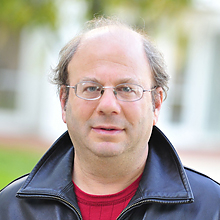David Jacobs

Professor
4240 Iribe Center
(301) 405-6802
(301) 314-911
Education:
Ph.D., MIT (Computer Science )
Special Awards/Honors:
2011 Edward O. Wilson Biodiversity Technology Pioneer Award
Biography:
David Jacobs is a professor of computer science with an appointment in the University of Maryland Institute for Advanced Computer Studies.
His research covers various aspects of computer vision and machine learning, with a focus on visual object recognition and handling lighting variations. Jacobs also explores image clustering, structure-from-motion, and the intersections of vision with user interfaces and graphics.
Go here to view Jacobs's academic publications on Google Scholar.
Publications
2000
2000. What makes viewpoint invariant properties perceptually salient?: A computational perspective Perceptual organization for artificial vision systems. :121-138.
2000. Breakout Session Report: Principles and Methods. Perceptual Organization for Artificial Vision Systems. :17-28.
2000. Perceptual Completion Behind Occluders: The Role of Convexity. Perceptual Organization for Artificial Vision Systems. :73-90.
1999
1999. Classification in non-metric spaces. Proceedings of the 1998 conference on Advances in neural information processing systems II. :838-844.
1999. 3-d to 2-d pose determination with regions. International Journal of Computer Vision. 34(2):123-145.
1999. The role of convexity in perceptual completion: beyond good continuation. Vision Research. 39(25):4244-4257.
1998
1998. Condensing image databases when retrieval is based on non-metric distances. Computer Vision, 1998. Sixth International Conference on. :596-601.
1998. Clustering appearances of 3D objects. Computer Vision and Pattern Recognition, 1998. Proceedings. 1998 IEEE Computer Society Conference on. :414-420.
1998. Comparing images under variable illumination. Computer Vision and Pattern Recognition, 1998. Proceedings. 1998 IEEE Computer Society Conference on. :610-617.
1998. Determining the similarity of deformable shapes. Vision Research. 38(15–16):2365-2385.
1998. EFFICIENT DETERMINATION OF SHAPE FROM MULTIPLE IMAGES CONTAINING PARTIAL INFORMATION. Pattern Recognition. 31(11):1691-1703.
1998. Uncertainty propagation in model-based recognition. International Journal of Computer Vision. 27(2):127-159.
1997
1997. Linear fitting with missing data: applications to structure-from-motion and to characterizing intensity images. Computer Vision and Pattern Recognition, 1997. Proceedings., 1997 IEEE Computer Society Conference on. :206-212.
1997. Recognition using region correspondences. International Journal of Computer Vision. 25(2):145-166.
1997. 3-D to 2-D recognition with regions. Computer Vision and Pattern Recognition, 1997. Proceedings., 1997 IEEE Computer Society Conference on. :547-553.
1997. Constancy and similarity. Computer Vision and Image Understanding. 65(3):447-449.
1997. Matching 3-D models to 2-D images. International Journal of Computer Vision. 21(1):123-153.
1997. Stochastic completion fields: A neural model of illusory contour shape and salience. Neural Computation. 9(4):837-858.
1997. Local Parallel Computation of Stochastic Completion Fields. Neural Computation. 9(4):859-881.
1996
1996. Robust and efficient detection of salient convex groups. Pattern Analysis and Machine Intelligence, IEEE Transactions on. 18(1):23-37.
1996. Matching convex polygons and polyhedra, allowing for occlusion. Applied Computational Geometry Towards Geometric Engineering. :133-147.
1996. The space requirements of indexing under perspective projections. Pattern Analysis and Machine Intelligence, IEEE Transactions on. 18(3):330-333.
1996. Space/time trade-offs for associative memory. Pattern Recognition, 1996., Proceedings of the 13th International Conference on. 4:296-302vol.4-296-302vol.4.
1995
1995. Stochastic completion fields: a neural model of illusory contour shape and salience. Computer Vision, 1995. Proceedings., Fifth International Conference on. :408-415.
1994
1994. Error propagation in full 3D-from-2D object recognition. Computer Vision and Pattern Recognition, 1994. Proceedings CVPR '94., 1994 IEEE Computer Society Conference on. :892-898.
1994. Generalizing invariants for 3-D to 2-D matching. Applications of Invariance in Computer Vision. :415-434.
1994. A study of affine matching with bounded sensor error. International Journal of Computer Vision. 13(1):7-32.
1994. Error propagation in 3D-from-2D recognition: Scaled-orthographic and perspective projections. Proceedings: ARPA Image Understanding Workshop, Monterey, California.
1994. Finding structurally consistent motion correspondences. Pattern Recognition, 1994. Vol. 1 - Conference A: Computer Vision Image Processing., Proceedings of the 12th IAPR International Conference on. 1:650-653vol.1-650-653vol.1.
1994. Segmenting independently moving, noisy points. Motion of Non-Rigid and Articulated Objects, 1994., Proceedings of the 1994 IEEE Workshop on. :96-103.
1993
1993. 2D images of 3-D oriented points. Computer Vision and Pattern Recognition, 1993. Proceedings CVPR '93., 1993 IEEE Computer Society Conference on. :226-232.
1992
1992. Space efficient 3-D model indexing. Computer Vision and Pattern Recognition, 1992. Proceedings CVPR '92., 1992 IEEE Computer Society Conference on. :439-444.
1992. A study of affine matching with bounded sensor error. Computer Vision—ECCV'92. :291-306.
1991
1991. Space and time bounds on indexing 3D models from 2D images. Pattern Analysis and Machine Intelligence, IEEE Transactions on. 13(10):1007-1017.
1991. Model group indexing for recognition. Computer Vision and Pattern Recognition, 1991. Proceedings CVPR '91., IEEE Computer Society Conference on. :4-9.
1991. Optimal matching of planar models in 3D scenes. Computer Vision and Pattern Recognition, 1991. Proceedings CVPR '91., IEEE Computer Society Conference on. :269-274.
1989
1989. Grouping for recognition. AI Memos (1959 - 2004).
1987
1987. GROPER: A Grouping Based Object Recognition System for Two-Dimensional Objects. IEEE Workshop on Computer Vision. :164-169.
